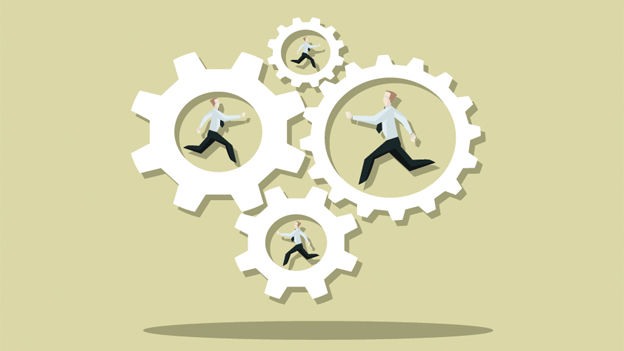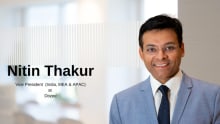HR at a crossroads: How can HR invest in HR?

Upgrades to the HR operating model will not come through ‘defined roles’ but will rather come from improved relationships
Effective HR professionals are credible activists because they build personal trust by meeting commitments, building relationships, and growing business acumen
HR for HR means that HR professionals apply to their own function the knowledge and tools they apply to their organizations. This means building the right HR organization by making sure that the HR department aligns with the business organization to ensure that they respond to future opportunities.
HR governance: Relationships more than roles
Debates continue about how to organize HR departments. Should HR work be centralized (functionally driven across an enterprise), decentralized (uniquely applied to each business), or some combination (shared services)? With others, we have tried to define the right roles that HR professionals play to have an optimal HR operating model. We have proposed that the HR structure should match business strategy and structure. In many cases, where a diversified business strategy has a divisional, networked, matrix, hybrid, or allied structure, we have proposed an HR operating model with service centers focused on technology enabled transaction capability, centers of expertise with deep specialized HR knowledge and insight, embedded HR generalists who adapt HR services to deliver business needs, and corporate HR leaders who set the overall policy. With good intent, many keep tweaking these HR roles to help the HR department and HR professionals deliver increased business value.
In our research of 12 key foci of an HR department, we found that ‘Having clear roles and responsibilities for each of the groups within HR (e.g., service centers, centers of expertise, embedded HR)’ ranks as among the best done but least impactful on business impact. On the other hand, ‘Connecting HR activities to external stakeholder expectations (e.g., customers, investors’ and ‘tracking and measuring the impact of HR’ were the two activities with highest business impact and least well done.
As we pondered over these findings and heard the ongoing debates about improving HR operating models, I have come to the conclusion that upgrades to the HR operating model will not come through ‘defined roles’ but will rather come from improved relationships. Imagine a family that is not getting along. They try to make their relationship work by buying new appliances, chairs, and couches without realizing that new furnishings won’t help a family get along better. They then go ahead and remodel their house or buy a new house with bigger rooms. Does that help? No. It’s the same with HR. Here, new HR tools and technologies are unlikely to improve the operations within the HR department. Likewise, merely changing boxes on organization charts won’t help HR professionals work better together.
For families to function better, they need to learn to belong, to focus on relationships more than roles. For HR operating models to deliver more value, once the basic roles are satisfied (e.g., matching HR structure to business strategy and structure), maybe we should focus more on relationships than roles.
Many have studied what makes relationships work better in friendships, couples, families, and communities. For example, John Gottman, a relationship scholar, has been able to predict with over 90 per cent confidence how couples will stay together. Similarly, let me propose six principles that, when applied, may improve HR operating models more than debates about roles.
Share a common purpose
Partners in a relationship have different roles to play, but they succeed when they realize that they are stronger together than apart because they have super ordinate and binding goals (e.g., raising children). Couples stay together when they share dreams, find meaning together, and create a culture of joint rituals and goals, while respecting individual skills.
Likewise, in HR, each role has unique expertise (service centers with technology driven efficiency, centers of expertise with specialized HR insights, embedded HR with business insights). The challenge is to find a unifying purpose that brings together these different parts into a greater whole. This binding purpose may be business performance (strategic HR) or improving customer or investor value (outside in HR). Each component of HR operations contributes unique value to serving customers, improving market value, and delivering business results.
Respect differences
In couple therapy, each partner is encouraged to identify and appreciate the strengths of their partner. Couples succeed when they communicate things positively than negatively. Gottman found a 5 to 1 ratio of positive to negative comments in successful couples. Others have found in work settings that leaders are more successful with a 3 to 1 positive to negative relationship ratio. Couples also succeed when they know and respond to their partner’s ‘love maps’ or what matters to their partner.
While it might be awkward to talk about ‘HR’s love maps’, the logic remains the same. Clearly, different parts of the HR operating model focuses on different activities, with HR service centers emphasizing standardized, consistent, and cost efficient solutions and embedded HR generalists working to create tailored HR solutions for unique business requirements. Embedded HR professionals define the talent, leadership, and cultural requirements to deliver business goals. Those working in centers of expertise have pride in their deep functional knowledge. Service center HR professionals ensure that the ‘trains run on time’ (systems do what they should). When these different groups respect each other, focus on what is right more than what is wrong, and yield to the influence of the other, they can form relationships that supersede their separate roles. When differences are respected, dissent becomes a positive and not a negative because there is tension without contention, disagreement with being disagreeable, dialogue without demeaning anyone, confrontation without being confrontational, and challenge without condemning.
Govern, Accept, Connect
A large part of relationship success comes from managing expectations. Researchers have found that 65 - 70 per cent of relationship problems are never ‘solved’ but just ‘managed’. Most of the problems early in a relationship are worked around e.g spending habits, raising children, doing household chores. It is important to solve solvable problems and not obsess about those that seem to persist.
Likewise, in HR, we may falsely assume that relationships among parts of HR will be congenial and automatically solved. More realistic expectations recognize that the processes used to govern HR will be more important than the solutions. For example, managing decision rights is less about who makes a decision and more about a process for who makes a decision because the decision right may vary over time. When different parts of an HR operating function can focus on creating a growth mindset, they worry less about the right answer and more about learning to negotiate and discuss. Managing differences with calmness, curiosity, and caring will help build connection among HR parts.
Care for the other
In relationship therapy, the most important questions that solidify a relationship are: ‘Can I rely on you?’, ‘Are you safe?’, ‘Will you be there for me when I need you?’ Without positive answers to these questions, relationships will crumble under pressure. With positive answers, partners build trust and delight in and celebrate others’ success. In HR departments, it is important that different parts of the operating model care for each other. There needs to be confidence that HR transaction work will be done on time and accurately. Centers of expertise need to be trusted that they will not impose answers, but collaborate to discover innovative solutions. Embedded HR professionals need to be able to accurately diagnose current and future business problems. Trust in the HR function should be high due to each area being predictable, dependable, available, accessible, and reliable. Different groups should be aware of scorecards for each group and be delighted when those in other groups do well. ‘We’ should replace ‘My’ as the metaphor for the HR industry to focus on HR unity.
Share experiences together
In any relationship, things can go wrong. A partner has personal or professional disappointments or a couple has stresses, which pull the partners apart. To build stronger personal relationships, partners are encouraged to turn to each other in times of difficulty, to yield to the influence of their partner, to make bids to each other (in successful relationships over 80 per cent of the bids are responded to), and to be emotionally vulnerable to share deeper feelings with each other. In the HR operating model, it is easy to isolate oneself in one’s group. It is more helpful to have individuals work across groups. This may mean career rotation from COEs to embedded HR roles and vice versa, group HR meetings or calls where the groups share concerns and celebrate successes, problem solving groups with representatives from each HR group, or informal contacts where HR bids are quickly attended to. In addition, when things go wrong in the HR operating model, and they will, rather than blame, complain, or hide, have the emotional confidence to admit a problem and seek a joint solution.
Grow together
Anyone in a successful relationship over 5-10 years can look back to see progress. Relationships morph and each partner in the relationship learns and grows. Some of this growth comes from constantly learning, from focusing on the future and what can be, from letting go of grievances, recognizing vicious cycles and breaking them. Couples with positive relationships recognize growth looking backward and anticipate future growth looking forward. HR departments need to learn from the past. The stories of HR success can be woven together into an historical narrative of how an HR department has made progress. Sometimes, HR groups don’t recognize the progress they have made. When the growth of the HR department focuses on the shared purpose of delivering sustainable business value, when differences are respected, when governance is managed, when caring occurs, and when HR professionals share time and energy, then the growth will likely be sustained. So, for the HR operating model to deliver real value, HR roles matter. Families need houses with rooms that reflect their lifestyle. But, relationships matter even more. A nice house will not ensure a well functioning family, nor will an elegant organization chart guarantee an effective HR operating model. Roles matter, but they matter less than relationships.
HR competencies for HR professionals
HR professionals also need to up their game to deliver value in today’s business setting. This means that HR professionals need to build relationships of trust with business leaders by being credible activists who are trusted because of their personal relationship and strong positions they take to build business success. These HR professionals must not only know the business, but be able to strategically position the business. They must master the processes of individual and institutional change. They must be knowledgeable in the science and art of HR. And, they must use information for better decision making. When they master this knowledge, skill, and ability, they can deliver the talent, leadership, and capability a business requires to compete in a changing world.
In a recent round of our competency research, we found that effective HR professionals function in six roles, as follows:
Strategic positioner. High performing HR professionals think and act from the outside-in by mastering four levels of business. First, they learn the language of the business, which revolves around finance. Like learning a foreign language, they may not speak like a native, but they need to be able to get around. Second, they need to participate actively and thoughtfully in helping to co-create their organizations’ strategy. Third, they need to target and serve key customers of their organization by identifying customer segments, knowing customer expectations, and aligning organizational actions to meet customer needs. Finally, they need to be knowledgeable of general business conditions (e.g., social, technological, economic, political, environmental, and demographic trends) that affect their respective industries and geographical regions. Strategic positioners go beyond knowing the business to being able to create and shape a business. They do HR from the outside-in by anticipating business conditions and building HR practices to respond.
Credible Activist. Effective HR professionals are credible activists because they build personal trust by meeting commitments, building relationships, and growing business acumen. Credibility comes when HR professionals do what they promise, build personal relationships of trust, and can be relied on. Trust comes through personal relationships that endure. As activists, HR professionals have a point of view, not only about HR activities, but about business demands. They learn how to influence others in a positive way through clear, consistent, and high impact communications. Finally, HR professionals need to be self-aware and committed to building their profession.
Capability Builder. An effective HR professional moulds individual abilities into effective organization capabilities. As discussed above, capability represents what the organization is good at and represents an organization’s institutional strengths and the reputation that the organization has relative to those strengths. Capabilities have been referred to as a company’s culture, process, or identity. HR professionals should facilitate capability audits to determine the identity of the organization.
Change Champion. As change champions, HR professionals make sure that isolated and independent organizational actions are integrated and sustained through disciplined change processes. HR professionals make an organization’s internal capacity for change match or lead the external pace of change. As change champions, HR professionals help make change happen at institutional (changing patterns), initiative (making things happen), and individual (enabling personal change) levels. To make change happen at these three levels, HR professionals play two critical roles in the change process. First, they initiate change by building a case for why change matters, overcoming resistance to change, engaging key stakeholders in the process of change, and articulating the decisions to start change. Second, they sustain change by institutionalizing change through ensuring organizational resources, designing organizational structures, facilitating systemic communications, and orchestrating continual learning. Our research found that HR professionals are better at initiating =change than sustaining change, but the ability to sustain change has more impact on business results. HR often starts more initiatives than they complete.
Human Resource Innovator and Integrator. Effective HR professionals should know the historical research on HR so that they can innovative and integrate HR practices into unified solutions to solve current and future business problems. They must know the latest insights and innovative developments on key HR practice areas related to human capital (talent sourcing, talent development), performance accountability (appraisal, rewards), organizational design (teamwork, organization development), and communication. They must also be able to turn these unique HR practice areas into integrated solutions, generally around an organization’s leadership brand. These innovative and integrated HR practices then result in high impact on business results by ensuring that HR practices maintain their focus over the long run and do not become seduced by HR ‘flavor the month’ or by another firm’s ‘best practices’.
Technology Proponent. In recent years, technology has changed the way in which HR people think and do their administrative and strategic work. At a basic level, HR professionals need to use technology to efficiently deliver HR administrative systems such as benefits, payroll processing, healthcare costs, and other administrative services. In addition, HR professionals need to use technology to help people stay connected with each other. This means that technology plays an increasingly important role in improving communications, do administrative work more efficiently, and connecting inside employees to outside customers. For example, leveraging social media enables the business to position itself for future growth. HR professionals who understand technology will create improved organizational identity outside the company and improve social relationships inside the company. As technology exponents, HR professionals have to access, advocate, analyze and align technology for information, efficiency, and relationships.
Conclusion: HR crossroads
This article lays out the content and process crossroads facing HR, to be architects and anthropologists; scientists and artists; strategic and operational. It also proposes three outcomes for HR, particularly with an outside-in perspective: talent (competence, commitment, and contribution), organization capability and culture, and leadership. And, we propose governing HR through relationships more than roles.
Without a doubt, the opportunities for HR to have real impact are greater then ever. Hopefully, with the right perspective, outcomes, and transformation, HR will fulfill its promises.











